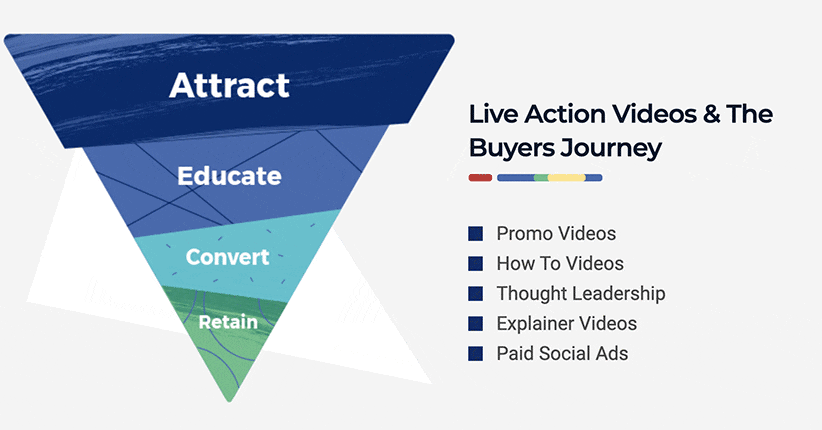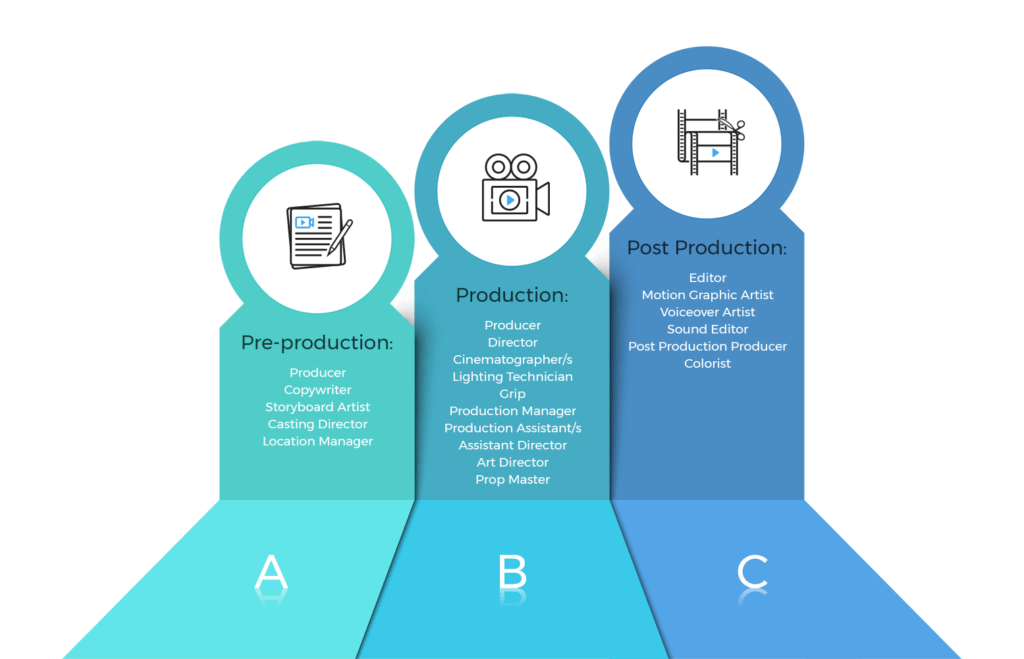Developing a Video Marketing Strategy
Video is the king of communication. It has the power to command attention and empower brands to tell more engaging stories than any other medium. A smart video marketing strategy will seize more moments and drive tangible results like increased conversion rates, click-through rates, time-on-page, social media shares, and ROI. In this article, we discuss how to develop a video marketing strategy by using the right types of video on the right channels with actionable insights to let brands shine bright.
Video Marketing Works
The effectiveness of video marketing has been proven by statistics. For example,
- on landing pages, video can increase conversion rates by up to 80%;
- in email, video leads to 200-300% increase in click-through rates (Hubspot);
- videos are shared 20 times more than other content; and
- 90% of customers say videos help them make buying decisions.
Yet, according to Buffer, “83% of marketers would increase their reliance on video as a strategy if there were no obstacles like time, resources, and budget.” In other words, video marketing works, and professional marketers want more of it.
Want a Great Video Marketing Strategy? Define Your “Why”
Why do you want to embrace a video marketing strategy for your organization?
At Marketing Reel, we believe in the power of expression. When you can fully express yourself, you put yourself in a balanced emotional state and in a better position to achieve success. This applies to individuals and brands. It’s not only about competition and being the best, but instead we believe in the simple act of being authentic to who you are. From this state, you naturally flow into the best version of yourself.
What better way to express yourself than through the power of video – the world’s leader in communication. This coupled with distribution on the world’s leading digital advertising platforms (Google, Facebook, YouTube, Instagram) allows brands to amplify their voice in a cluttered competitive landscape and achieve their desired business results. However, the path to successfully achieving your business goals start with a worthwhile “why” that provides the motivation, amidst the toughest times, to continue to strive and prosper.
Brand is not some image you fabricate out of thin air. Instead it is about shining a light on who you already are. Let that light shine bright through the power of video and watch your customers naturally gravitate towards you.
Brand is about shining a light on who you already are.
Business Goals Guide Your Video Marketing Strategy
From a business standpoint, what are you looking to achieve by developing video content? Do you seek to build awareness, increase leads, drive online sales, increase customer retention–or maybe a mix of those?
Your business goals inform the types of videos you produce and the marketing channels you use.
Perhaps you have a devoted audience but aren’t getting the results you hoped for. It might be the time to tap into the power of video in order to increase your return on investment. According to Hubspot, “after watching a video, 64% of users are more likely to buy a product online. Again, this requires careful analysis so the right type of videos, distribution channels, and targeting are used to maximize impact. We’ll address those in the coming sections.
According to Hubspot, “after watching a video, 64% of users are more likely to buy a product online.”
Do you want to achieve your business goals through a specific campaign, a general funnel that runs in the background, or both?
A campaign will focus on driving results surrounding a specific service and/or product within a certain timeframe. An “evergreen” funnel is always running in the background and is intended to generally usher prospects through the buyer’s journey.
Clarify your business goals from the outset to lay a proper foundation for your video strategy. These decisions will inform many other choices along the way.
Who Do You Want to Reach with Your Video Marketing Strategy?
Dig deep into who your ideal target audience is by identifying their gender, age, location, perhaps even race/ethnicity, and more. You must get to know them well so that they become real characters in your world. When you understand who you are talking to, you can craft videos that speak clearly to their interests, behaviors, and demographics.
This level of detail will inform your video creation process. You will create emotionally compelling content that moves your audience to take action by speaking to their unique interests and behaviors. Knowing your audience’s unique characteristics will also allow you to find them and reach them on the right channels.
When you understand who you are talking to, you can craft videos that speak more clearly to the interests, behaviors and demographics of your target audience.
Where Are You Now?
Now that you understand your business goals, who you want to reach, and the deep meaning behind using video to achieve your business goals, it is time take inventory of your current video assets and analyze how they fit into the overall buyer’s journey.
At Marketing Reel, we have developed several videos that satisfy every stage of the buyer’s journey.
Attract:
Promo Videos,
Educational Videos,
Thought Leadership,
Explainer Videos
Educate:
Explainer videos,
Personalized Video,
Reel Case Studies and Testimonials,
Culture Videos,
Thought Leadership
Convert:
Case Studies & Testimonials,
Demo Videos,
Personalized Video
Retain:
Culture Videos,
Case Studies and Testimonial Videos,
Personalized Video

It is key to analyze the videos that your organization currently has so that you can identify gaps where videos need to be added in order to achieve your intended business results.
Clarify Which Video Types & Distribution Channels You Need
After completing your “why”, business goals, target audience, and current video assessment, it’s time to decide which types of videos to create.
Certain types of videos trigger your prospect to take specific actions compared to other videos. It is crucial to select the correct video types so you can pull the proper emotional levers that will motivate your prospect toward your intended action.
Remember, a well thought out video marketing strategy should produce multiple video assets that drive viewers toward an intended goal.
After you select your videos, you must clarify where you want them to be distributed so you can put them in front of your target audience and achieve maximum impact.
In order to look at this more clearly, it may be helpful to distinguish between owned, earned and paid media:
Owned media is any type of marketing channel that your brand is in full control of. Examples include your website, blog, email newsletter and social media channels.
Earned media refers to content that is written about your business that you haven’t paid for or created yourself. This includes word of mouth, customer reviews, and any article or video made by a third party highlighting your brand.
Paid media is content you pay to promote via sponsored social media, display ads, search results, video ads, pop-ups, and other multimedia. As a result, brands can often amplify results at a faster pace using paid media compared to other models.
A well balanced video marketing strategy will not rely solely on one type of media in order to achieve results. Often a mixture of owned, earned and paid media is needed in order to optimize results. Once your video marketing strategy is functioning fluidly across multiple channels, it will provide predictable and consistent results.
Create Your Video Marketing Strategy Budget [and Choose Who Will Create the Videos]
As you move toward creating videos, you must distinguish between in-house production versus outsourcing to an agency.
These two different options can result in varying cost structures, video quality, delivery timeframes, etc. We will explore the various pros and cons of each. However, you don’t need to tie yourself to one approach or the other. Most brands use a mixture of in-house and outsourced talent in order to create their video content.
In-house production versus outsourcing to an agency can result in varying cost structures, video quality, delivery timeframes, etc.
Estimate Your Production Budget
Before you start producing videos, you need to nail down your budget. Use industry averages as benchmarks in for pricing both in-house production vs. outsourcing to an agency/production company
In-house production teams are a small group of employees that create video content for the brand that employs them. Most of the time it is an in-house videographer who is responsible for filming, lighting, and editing a project.
According to Payscale.com, the average salary of a videographer in the United States is about $65K per year. You can expect to pay this roughly for each member of your in-house team.
When it comes to producing one-off video through an agency/production company, you are looking at a cost between $5K – $15K per video. This range covers the most common types of videos, including live action, 2d & 3d animation, virtual reality, 360° tours, etc. Certain styles, such as 3d animation, are typically priced higher. Consider all this when you select the types of videos you wish to incorporate into your video marketing strategy.
Other pricing models include monthly retainers for video creation. For instance, at Marketing Reel, we offer our Reel Content product, which provides consistent monthly videos at a monthly rate. This type of contract is typically a year long and allows brands to produce video content economically and at scale.
How Do You Arrive at a Number?
Whether you’re integrating an owned, earned, or paid media strategy, it’s crucial to control your spending to ensure your campaign is profitable.
Understanding Profitability
Video marketing campaigns start with a specific objective in mind (i.e., acquire 10 new customers.) You must understand the bottom line profit of that objective versus the cost of achieving it. You arrive at this by understanding some crucial aspects of your business:
A) It starts with the Average Order Value of your product or service, which is the average amount that a customer spends with you.
B) Then you must calculate your Average Order Profit, which is the amount of profit you make before spending any money on advertising. You can calculate this by taking your average order value and subtracting it from your Cost of Goods Sold (COGS).
C) From this, you can back into your Cost Per Acquisition, which is essentially how much you are willing to spend in order to acquire a new client. A general rule of thumb for arriving at this figure is to take the Average Order Profit and divide it by 2.
Understanding Cost
Now you must explore the costs on the video marketing side. They will typically include all video production costs plus the distribution costs plus any fees paid to outsourced vendors.
If the cost per acquisition exceeds the figure in your initial equation, then the strategy is overextended and you must cut costs.
With all this being said, each brand and the tactics they use are unique. Some companies are willing to accept a short-term loss to achieve a greater business objective. For most companies, these guidelines will help generate a video marketing strategy grounded in data that is measurable for profitability.
Whether you are integrating an owned, earned, or paid media strategy, it is crucial to control your spending to ensure your campaign is profitable.
Set Responsibility for Video Creation
At this point, you understand your audience, overarching business goals, and the videos you need to achieve those goals. Allocating responsibility for creating those videos is key to developing a video marketing strategy that is actionable. Each one has pros and cons, and companies will often take a mixed-bag approach to see what works best. Below are some of the main elements of video creation, as well as how they will be impacted by going in-house versus outsourcing to an agency/production company.
Video Types & Messaging
Using outside talent can potentially provide a fresh perspective that resonates more deeply with your target audience. In-house teams can fall prey to groupthink. When developing video content, they lose objectivity because they are so close to the brand. Another result of this is that internal teams typically gravitate towards complex industry lingo surrounding their brand and its products/services. This can often bleed into the communication that the brand has with its audiences and create confusion. When a brand brings in an outside perspective, it can help streamline and clarify messaging to reach the audience in a way the company itself cannot.
On the other hand, in-house teams’ familiarity with and innate understanding of their brand can be a positive. They can more accurately and easily develop videos that surround the inner workings of their organization. These videos include but are not limited to company culture , personalized, product explainer, case studies and customer testimonials videos.
In-house teams are typically effective at tackling videos in the Educate and Convert phases of the buyer’s journey because they require specific brand knowledge that someone from the outside would know.
Outside agencies face a steeper learning curve, which can lead to slower deliverables, missteps in video messaging, and continuous need for correction. However, distance from the brand, along with robust video capabilities, is a combination that lends itself to the creation of videos in the Awareness and Retain phases. Outsourced talent will be able to communicate more clearly to those that aren’t aware of the brand while also providing the dynamic production capabilities to grab their attention and hold it.
Craftsmanship & Knowledge
Most agencies/production companies will have more experienced and skilled craftsmen than an in-house team. Outsourced companies are typically hyper-focused on their service and enlist more highly skilled, specialized talent to work on their projects. They will also have specialized knowledge and resources that address each stage of pre-production, production, and post production more thoroughly. For a standard video production project they may enlist the help of the below crew members:

Pre-production: Producer | Copywriter | Storyboard Artist | Casting Director | Location Manager
Production: Producer | Director | Cinematographer/s | Lighting Technician | Grip | Production Manager | Production Assistant/s | Assistant Director | Art Director | Prop Master
Post Production: Editor | Motion Graphic Artist | Voiceover Artist | Sound Editor | Post Production Producer | Colorist
When it comes to in-house production, you will often find one person or a select few juggling many of the tasks highlighted above. They are typically videographers that may still be learning their craft and are faced with tackling the entire production process by themselves or with a small team.
With a more specialized workforce comes additional industry knowledge and reach that cannot be replicated by a smaller in-house team. Intangibles, such as knowledge of production facilities/locations, high quality actor options, and video stylistic choices, are the result of years of experience that many agency partners/production companies have.
In the end, outsourced agencies/production companies bring a skilled, specialized, and knowledgeable workforce that often produces a more refined final product.
Outsourced agencies/production companies bring a skilled, specialized, and knowledgable workforce that often produces a more refined final product than in-house production teams.
Equipment, Software and Hardware
Working with an agency typically allows access to more sophisticated film equipment, editing/graphics software, as well as computing hardware. Larger investments in the software, hardware and overall processes enable agencies to execute at a higher level than in-house creators. In-house teams often won’t invest in this and may not have the depth of knowledge to even use it.
Having specialized equipment, software, and hardware can make a significant difference in the quality of deliverables and faster delivery times.
Pricing
Working with an in-house team will often be more cost effective when compared to industry standard rates that agencies charge. The reasons for this are simple. Agencies get paid a premium for the industry knowledge, job specialization, and sophisticated hardware/software they bring to the table.
When you produce videos in-house, you often pay a locked-in rate that is cheaper on a per-video basis. However, because outsourced agencies have more specialized knowledge, they are more likely to provide accurate pricing and avoid hidden costs. So although their pricing is often higher, it is also more accurate.
It is more common for in-house teams to make errors in estimating prices, or worse–in the actual production. This causes unpredictable and often unnecessary costs that could have been avoided by working with an outsourced specialist.
Turnaround Times
Since a brand’s in-house team is usually on standby, they can typically churn out more content at a faster rate. On the other hand, agencies often work with several clients at a time. Often their schedule may not be as wide open for you and you would like. This applies not only to scheduling out deadlines but also to turning around notes during the revision process.
You will often experience faster turnaround times from an in-house team, but the tradeoff for that speed is a reduction in quality compared to your outsourced agency.
When choosing who should take ownership of your video creation, carefully examine your business goals, audience targeting, video types, distribution channels, and budget. Additionally, many of the other factors mentioned above should be weighed in the decision making process. Most importantly, don’t feel compelled to use one or the other. In fact, most video marketing strategies require a blend of in-house creators and outsourced talent in order to effectively and efficiently execute the video marketing strategy.
Set Brand Guidelines & Styles for Your Video Marketing Strategy
After laying the foundation of your video marketing strategy, it’s time to address the aesthetics and sounds that consistently define your videos. A consistent look and feel across all of your videos promotes the cohesion of your brand. The repetition and consistency in your videos will allow your current customers and prospects to recall your brand more readily. As a result, they will be more likely to purchase your product or service.
Your videos can be created in a multitude of styles, as long as they fall under the appropriate umbrella of brand and style guidelines. Some key considerations include:
Define logo and animated logo standards in terms of size, position, movement, color, etc.
What font types will be consistently used across all videos?
What brand colors encapsulate the brand and should be used more readily within the various type of videos?
Define the standards and process of captioning your videos.
Make sure the overall tone in the storytelling and script writing is on-brand. Is your brand messaging funny? Or is it more thoughtful and endearing? The tone should be carried throughout.
What types of Calls To Action will be used to drive your prospects further down the buyer’s journey?
Off to the Races!
You’ve taken a strategic, thorough approach to your video marketing strategy. Now it’s time to put your plan into action!
Be aware that marketing as whole is a process of trial and error that leads to iterative refinement. You won’t get it right the first time out. Your strategy will require tweaks along the way to achieving your business goals. This is a natural process of honing in on what works and what doesn’t. As you do it, the magic will begin to unfold before your eyes. However, to arrive at this point, you must properly track the data to measure the performance of your efforts. This is the next and final step.
Data-driven Insights about Your Video Marketing Strategy
Transparent and accurate data are absolutely critical to understanding how your video marketing campaign is performing. First and foremost, you must understand what metrics to track so you can better gauge the performance of your videos. Track a few key metrics, including how long people are staying engaged in your video content and who is viewing it. Lastly, analyzing ROI will allow you to trace back key conversions outlined in your business goal to specific videos.
When you understand these metrics, you can double down on the creative videos and marketing channels that are working. You can also identify and think about how to re-target viewers who have shown interest in your products and services.
Conclusion
Implementing a successful video marketing strategy is about being proactive, strategic and detail oriented in your approach. When you do this, you will be able to map the right content to the right channels while tracking the correct insights. All of this will ensure that you are using video in an optimal way so that it produces real business impact.







